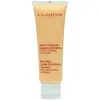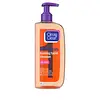What's inside
What's inside
 Key Ingredients
Key Ingredients

 Benefits
Benefits

 Concerns
Concerns

 Ingredients Side-by-side
Ingredients Side-by-side

Water
Skin ConditioningSodium Laureth Sulfate
CleansingCetearyl Alcohol
EmollientCellulose
AbsorbentCocamidopropyl Betaine
CleansingLauramide Mipa
Glycol Distearate
EmollientCetearyl Glucoside
EmulsifyingGlycerin
HumectantAcrylates/C10-30 Alkyl Acrylate Crosspolymer
Emulsion StabilisingTea-Cocoyl Glutamate
CleansingCitrus Aurantium Dulcis Fruit Water
MaskingSilica
AbrasivePersea Gratissima Fruit Butter
EmollientParfum
MaskingPhenoxyisopropanol
PreservativeSodium Chloride
MaskingPropylene Glycol
HumectantSodium Hydroxide
BufferingBenzophenone-2
MaskingButylparaben
MaskingDisodium EDTA
Methylchloroisothiazolinone
PreservativeMoringa Oleifera Seed Extract
Skin ConditioningMethylisothiazolinone
PreservativeChlorphenesin
AntimicrobialEthylparaben
PreservativeMethylparaben
PreservativeBHT
AntioxidantBenzyl Salicylate
PerfumingButylphenyl Methylpropional
PerfumingLimonene
PerfumingLinalool
PerfumingGeraniol
PerfumingCI 15985
Cosmetic ColorantWater, Sodium Laureth Sulfate, Cetearyl Alcohol, Cellulose, Cocamidopropyl Betaine, Lauramide Mipa, Glycol Distearate, Cetearyl Glucoside, Glycerin, Acrylates/C10-30 Alkyl Acrylate Crosspolymer, Tea-Cocoyl Glutamate, Citrus Aurantium Dulcis Fruit Water, Silica, Persea Gratissima Fruit Butter, Parfum, Phenoxyisopropanol, Sodium Chloride, Propylene Glycol, Sodium Hydroxide, Benzophenone-2, Butylparaben, Disodium EDTA, Methylchloroisothiazolinone, Moringa Oleifera Seed Extract, Methylisothiazolinone, Chlorphenesin, Ethylparaben, Methylparaben, BHT, Benzyl Salicylate, Butylphenyl Methylpropional, Limonene, Linalool, Geraniol, CI 15985
Water
Skin ConditioningTriethanolamine
BufferingMyristic Acid
CleansingC9-15 Alkyl Phosphate
CleansingLauric Acid
CleansingGlycerin
HumectantHydroxypropyl Methylcellulose
Emulsion StabilisingCocamidopropyl Betaine
CleansingPhenoxyethanol
PreservativeParfum
MaskingMethylparaben
PreservativeBHT
AntioxidantPropylparaben
PreservativeEthylparaben
PreservativeCI 14700
Cosmetic ColorantSolvent Yellow 33
 Reviews
Reviews

Ingredients Explained
These ingredients are found in both products.
Ingredients higher up in an ingredient list are typically present in a larger amount.
BHT is a synthetic antioxidant and preservative.
As an antioxidant, it helps your body fight off free-radicals. Free-radicals are molecules that may damage your skin cells.
As a preservative, it is used to stabilize products and prevent them from degrading. Specifically, BHT prevents degradation from oxidation.
The concerns related to BHT come from oral studies; this ingredient is currently allowed for use by both the FDA and EU.
However, it was recently restricted for use in the UK as of April 2024.
Learn more about BHTCocamidopropyl Betaine is a fatty acid created by mixing similar compounds in coconut oil and dimethylaminopropylamine, a compound with two amino groups.
This ingredient is a surfactant and cleanser. It helps gather the dirt, pollutants, and other impurities in your skin to be washed away. It also helps thicken a product and make the texture more creamy.
Being created from coconut oil means Cocamidopropyl Betaine is hydrating for the skin.
While Cocamidopropyl Betaine was believed to be an allergen, a study from 2012 disproved this. It found two compounds in unpure Cocamidopropyl Betaine to be the irritants: aminoamide and 3-dimethylaminopropylamine. High-grade and pure Cocamidopropyl Betaine did not induce allergic reactions during this study.
Learn more about Cocamidopropyl BetaineEthylparaben is a preservative, is a paraben, and is not reef safe.
Glycerin is already naturally found in your skin. It helps moisturize and protect your skin.
A study from 2016 found glycerin to be more effective as a humectant than AHAs and hyaluronic acid.
As a humectant, it helps the skin stay hydrated by pulling moisture to your skin. The low molecular weight of glycerin allows it to pull moisture into the deeper layers of your skin.
Hydrated skin improves your skin barrier; Your skin barrier helps protect against irritants and bacteria.
Glycerin has also been found to have antimicrobial and antiviral properties. Due to these properties, glycerin is often used in wound and burn treatments.
In cosmetics, glycerin is usually derived from plants such as soybean or palm. However, it can also be sourced from animals, such as tallow or animal fat.
This ingredient is organic, colorless, odorless, and non-toxic.
Glycerin is the name for this ingredient in American English. British English uses Glycerol/Glycerine.
Learn more about GlycerinMethylparaben is a preservative and is a paraben. It is used to prevent the growth of fungus, mold, and other harmful bacteria. Parabens are chemicals used as preservatives in both cosmetics and food.
Methylparaben can be synthetically created. It can also be found naturally in some fruits, such as blueberries.
Oftentimes, Methylparaben is combined with other parabens to help increase the shelf life.
The safety of Methylparaben is currently being studied. While ongoing studies are looking into the safety of parabens, the results have been very mixed. Some studies have not found Methylparaben to be harmful.
Learn more about MethylparabenParfum is a catch-all term for an ingredient or more that is used to give a scent to products.
Also called "fragrance", this ingredient can be a blend of hundreds of chemicals or plant oils. This means every product with "fragrance" or "parfum" in the ingredients list is a different mixture.
For instance, Habanolide is a proprietary trade name for a specific aroma chemical. When used as a fragrance ingredient in cosmetics, most aroma chemicals fall under the broad labeling category of “FRAGRANCE” or “PARFUM” according to EU and US regulations.
The term 'parfum' or 'fragrance' is not regulated in many countries. In many cases, it is up to the brand to define this term.
For instance, many brands choose to label themselves as "fragrance-free" because they are not using synthetic fragrances. However, their products may still contain ingredients such as essential oils that are considered a fragrance by INCI standards.
One example is Calendula flower extract. Calendula is an essential oil that still imparts a scent or 'fragrance'.
Depending on the blend, the ingredients in the mixture can cause allergies and sensitivities on the skin. Some ingredients that are known EU allergens include linalool and citronellol.
Parfum can also be used to mask or cover an unpleasant scent.
The bottom line is: not all fragrances/parfum/ingredients are created equally. If you are worried about fragrances, we recommend taking a closer look at an ingredient. And of course, we always recommend speaking with a professional.
Learn more about ParfumWater. It's the most common cosmetic ingredient of all. You'll usually see it at the top of ingredient lists, meaning that it makes up the largest part of the product.
So why is it so popular? Water most often acts as a solvent - this means that it helps dissolve other ingredients into the formulation.
You'll also recognize water as that liquid we all need to stay alive. If you see this, drink a glass of water. Stay hydrated!
Learn more about Water